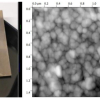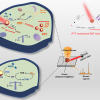Two-dimensional (2D) materials have attracted significant interest in recent years due to their unique electrical and mechanical properties, alongside atomically-thin dimensions. While graphene was the first 2D material to be studied in detail, there is now also a focus on other 2D materials with diverse properties and new applications. Among these, single-layer molybdenum disulphide (MoS2), a semiconducting 2D material, is generating a lot of interest due to its technologically exploitable electronic and optical properties that could pave the way for the next generation of electronics and optoelectronics devices.
In order to commercialise electronic devices made of 2D materials, industry faces a challenge to carry out quality control checks without destroying or damaging the material. As a single-layer of a 2D material is only a single atom or molecule thick, assessing their quality so far has only been possible using destructive techniques. Defects are expected to critically impact the performance of MoS2-based electronic devices, so the ability to investigate and quantify the number of defects without causing damage is crucial for enabling large-scale manufacture of the material, device fabrication and material functionalisation.
Oxford Instruments were looking to develop a new deposition system and process that could produce MoS2 in a more industrially-scalable manner. They turned to research from the National Graphene Metrology Centre (NGMC) at the National Physical Laboratory (NPL) published in Physical Review B.
“We were investigating the use of Raman spectroscopy for characterising MoS2 and found that it is a viable high-throughput and non-destructive technique for quantifying defects in this exciting 2D material”, recalls Dr Andrew Pollard, Senior Research Scientist at NPL. “Importantly for this study we could controllably introduce known defects into MoS2 as a first step, using a technique from our previous work in graphene.”
Due to this, says Dr Ravi Sundaram, Senior Scientist at Oxford Instruments, “we were able to use NPL’s industrially-focused research as a framework for developing our own quality control measure that uses Raman spectroscopy to quantify defects in MoS2 produced using chemical vapour deposition. While such techniques are widely used for graphene, there was no established way of checking the quality of MoS2 in a non-destructive manner before NPL’s work was published. Being able to measure the quality of the material enables us to optimise the growth process. This ensures we are able to provide very high quality, low defect density MoS2 films from our tools.” See paper in Journal of Physics D.
NPL’s work on MoS2 provided Oxford Instruments with the methodology they needed to develop their own quality control process, which characterises the 2D MoS2 layers without having a destructive impact on the material’s structure. This enables the team to efficiently characterise the MoS2 produced via an industrially scalable technology, helping to accelerate the commercialisation of 2D materials.














